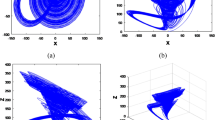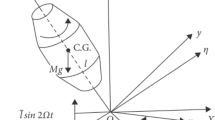Abstract
In a supermarket refrigeration, the temperature in a display case, surprisingly, influences the temperature in other display cases. This leads to a synchronous operation of all display cases, in which the expansion valves in the display cases turn on and off at exactly the same time. This behavior increases both the energy consumption and the wear of components. Besides this practical importance, from the theoretical point of view, synchronization, likewise stability, Zeno phenomenon, and chaos, is an interesting dynamical phenomenon. The study of synchronization in the supermarket refrigeration systems is the subject matter of this work. For this purpose, we model it as a hybrid system, for which synchronization corresponds to a periodic trajectory. To examine whether it is stable, we transform the hybrid system to a single dynamical system defined on a torus. Consequently, we apply a Poincaré map to determine whether this periodic trajectory is asymptotically stable. To illustrate, this procedure is applied for a refrigeration system with two display-cases.
Similar content being viewed by others
References
L. F. S. Larsen, C. Thybo, R. Wisniewski, et al. Synchronization and desynchronizing control schemes for supermarket refrigeration systems. The 16th IEEE International Conference on Control Applications. Part of IEEE Multi-conference on Systems and Control. Piscataway: IEEE, 2007: 1414–1419.
C. Sonntag, A. Devanathan, S. Engell. Hybrid nmpc of a supermarket refrigeration system using sequential optimization. Proceedings of the 17th IFAC World Congress. Seoul: Elsevier, 2008.
D. Sarabia, F. Capraro, L. F. S. Larsen, et al. Hybrid NMPC of supermarket display cases. Control Engineering Practice, 2009, 17(4): 428–441.
C. Thybo, L. F. S. Larsen. Method of Analysing a Refrigeration System and a Method of Controlling a Refrigeration System. US patent Application, 2011: US7992396 B2.
I. Blekhman, A. Fradkov, H. Nijmeijer, et al. On selfsynchronization and controlled synchronization. Systems & Control Letters, 1997, 31(5): 299–305.
A. Pikovsky, Y. Maistrenko, eds. Synchronization: Theory and Application. NATO Science Series II: Mathematics, Physics and Chemistry. Dordrecht: Kluwer Academic Publishers, 2003.
R. Goebel, R. G. Sanfelice, A. R. Teel. Hybrid dynamical systems. IEEE Control Systems Magazine, 2009, 29(2): 28–93.
A. Ames, S. Sastry. A homology theory for hybrid systems: Hybrid homology. Proceedings of the 8th International Workshop on Hybrid Systems: Computation and Control. Berlin: Springer-Verlag, 2005: 86–102.
S. Simis, K. Johansson, S. Sastry, et al. Towards a geometric theory of hybrid systems. Proceedings of the 3rd International Workshop on Hybrid Systems: Computation and Control. Berlin: Springer-Verlag, 2000: 421–436.
R. Wisniewski. Towards modelling of hybrid systems. Proceedings of the 45th IEEE Conference on Decision and Control. Piscataway: IEEE, 2006: 911–916.
T. Kousaka, T. Ueta, H. Kawakami. Bifurcation of switched nonlinear dynamical systems. IEEE Transactions on Circuits and Systems II: Analog and Digital Signal Processing. New York: IEEE, 1999: 878–885.
I. Hiskens, P. Reddy. Switching-induced stable limit cycles. Nonlinear Dynamics, 2007, 50(3): 575–585.
J. M. Goncalves, A. Megretski, M. Dahleh. Global stability of relay feedback systems. IEEE Transactions on Automatic Control, 2001, 46(4): 550–562.
J. M. Goncalves, A. Megretski, M. A. Dahleh. Global analysis of piecewise linear systems using impact maps and surface Lyapunov functions. IEEE Transactions on Automatic Control, 2003, 48(12): 2089–2106.
A. Schild, J. Lunze. Stabilization of limit cycles of discretely controlled continuous systems by controlling switching surfaces. Hybrid Systems: Computation and Control. Berlin: Springer-Verlag, 2007: 515–528.
A. Schild, J. Lunze. Switcheing surface design for periodically operated discretely controlled continuous systems. Hybrid Systems: Computation and Control. Berlin: Springer-Verlag, 2008: 471–485.
G. E. Bredon. Topology and Geometry. Graduate Texts in Mathematics. New York: Springer-Verlag, 1997.
R. Wisniewski, J. Leth. Convenient model for systems with hystereses-control. The 50th IEEE Conference on Decision and Control and European Control Conference. New York: IEEE, 2011: 6140–6145.
J. Leth, R. Wisniewski. On formalism and stability of switched systems. Journal of Control Theory and Application, 2012, 10(2): 176–183.
W. M. Haddad, V. Chellaboina, S. G. Nersesov. Impulsive and Hybrid Dynamical Systems. Princeton Series in Applied Mathematics. Princeton: Princeton University Press, 2006.
R. Wisniewski, L. F. S. Larsen. Method for analysis of synchronization applied to supermarket refrigeration system. Proceedings of the 17th IFAC World Congress. Seoul: IFAC, 2008.
Author information
Authors and Affiliations
Corresponding author
Additional information
This work was supported by the Danish Council for Technology and Innovation.
Rafael WISNIEWSKI is a professor in the Section of Automation & Control, Department of Electronic Systems, Aalborg University. He receives his Ph.D. in Electrical Engineering in 1997, and Ph.D. in Mathematics in 2005. In 2007–2008, he was a control specialist at Danfoss A/S. His research interest is in system theory, particularly in hybrid systems.
John LETH received his M.S (2003) and Ph.D. (2007) degrees from the Department of Mathematical Sciences, Aalborg University, Denmark. Currently, he is employed as Assistant Professor at the Department of Electronic Systems, Aalborg University. His research interests include mathematical control theory and (stochastic) hybrid systems.
Jakob Gulddahl RASMUSSEN is an associate professor at the Department of Mathematical Sciences, Aalborg University, Denmark. He received his Ph.D. in Statistics in 2006 also at the Department of Mathematical Sciences. His research interests include spatial statistics and stochastic processes (including stochastic hybrid systems).
Rights and permissions
About this article
Cite this article
Wisniewski, R., Leth, J. & Rasmussen, J.G. Analysis of synchronization in a supermarket refrigeration system. Control Theory Technol. 12, 154–162 (2014). https://doi.org/10.1007/s11768-014-0077-2
Received:
Revised:
Accepted:
Published:
Issue Date:
DOI: https://doi.org/10.1007/s11768-014-0077-2




